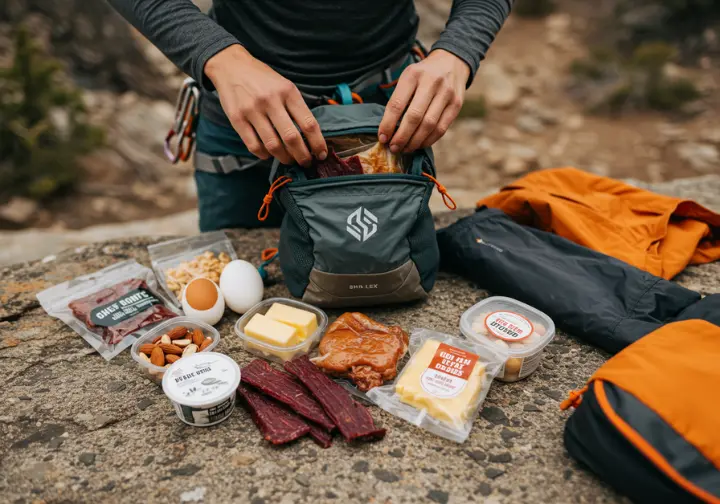In this article
This article confronts the core challenge of using a carbohydrate-limiting diet to fuel peak power, a quality traditionally reliant on anaerobic, glycogen-fueled energy systems. It presents a deep-dive investigation into the high protein high fat low carb diet, exploring the science, practical application, and potential pitfalls for dedicated climbers. We will examine how a low carb high protein high fat diet might enhance or sustain power for explosive moves, weigh anecdotal success against scientific evidence, and provide a comprehensive guide to help you decide if it’s a viable strategy for your performance goals. The discussion will cover defining the diet, its impact on power, practical implementation, and the risks versus rewards.
Understanding the HPHFLC Spectrum: More Than Just “Keto”

Before diving into performance impacts, it’s vital to have a clear understanding of what a High Protein, High Fat, Low Carb diet entails for an athlete. This approach is distinct from other low-carb diets, primarily because of the critical role of protein, a variance that can lead to different physiological states and outcomes.
Defining the High Protein, High Fat, Low Carb Diet
A High Protein, High Fat, Low Carb (HPHFLC) diet is a dietary plan marked by a macronutrient profile that significantly reduces carb intake while elevating both dietary protein and dietary fats. Different from a standard ketogenic diet, the protein component is often higher, going beyond the typical recommended dietary allowance (RDA). It can reach 1.2-2.0 g/kg of body weight, which is optimal for active people to support muscle repair. Carbohydrates are typically limited to under 26% of total calories, while fat intake increases to become a primary energy source.
This dietary framework is not a single, rigid protocol but a spectrum of low carb diets. For instance, on a 2,000-calorie diet, a 70kg climber might consume 156-219g of protein. The main physiological objective of this high protein diet is to shift the body’s primary fuel source from glucose to fats, a process known as fat adaptation, which can be an effective tool for fat loss. This change is relevant for climbers seeking consistent energy from encompassing a variety of nutrient-dense options during long sessions without the crashes tied to high carbohydrate intake.
HPHFLC vs. Ketogenic vs. Paleo: Critical Distinctions for Climbers
The most important distinction between an HPHFLC diet and standard ketogenic diets like the atkins diet is the protein intake. An SKD usually moderates protein to about 20% of calories to prevent gluconeogenesis, a metabolic process where the liver converts excess amino acids into glucose. This glucose production can stop the body from entering deep ketosis. Understanding how low-carb differs from keto is fundamental.
An HPHFLC diet, with its greater protein content, might not always be ketogenic. If protein consumption is very high, the diet remains very-low-carbohydrate but could limit ketosis. Compared to a plant based diet like Paleo, HPHFLC is more focused on macronutrient ratios than food origins when navigating the world of very low-carbohydrate (VLC) diets. Paleo eliminates grains but doesn’t strictly limit carbs from fruits and starchy vegetables, so it isn’t always a true low-carb diet.
The Physiology of Fat Adaptation and Metabolic Flexibility
Fat adaptation is the core physiological change that happens after weeks or months of sustained adherence to low-carbohydrate diets. During this time, the body enhances the pathways needed to efficiently burn fatty acids for energy. For climbers, this means tapping into nearly limitless fat stores. The initial transition, however, is often marked by the “keto flu,” with symptoms like fatigue and headaches as the body adapts.
Properly managing electrolytes and hydration is vital. While fat adaptation is beneficial, a potential drawback is a possible reduction in metabolic flexibility. This is the body’s ability to switch between fuels. Some research, like a pilot trial comparing high-fat and high-carbohydrate diets, suggests prolonged fat diets could down-regulate the body’s capacity to use carbohydrate, which may be detrimental for explosive power. This is part of the metabolic shift from carbohydrate to fat-based energy.
Analyzing the Impact of an HPHFLC Diet on Climbing Performance

The central theme for any climber considering this type of dietary approach is how it influences the specific physiological components of performance. Here, we’ll explore the “Peak Power Paradox” by examining scientific evidence for and against its use in anaerobic sports. We will also discuss more reliable benefits, such as an improved strength-to-weight ratio.
The Peak Power Paradox: Can You Fuel Explosive Moves Without Carbs?
Peak power in climbing, for moves like dynos and deadpoints, is an explosive, short-duration effort. These movements are traditionally fueled by anaerobic energy systems—the ATP-PC and glycolytic systems—which rely heavily on stored muscle glycogen from complex carbs. The paradox is that an HPHFLC diet severely restricts the main substrate needed. A systematic review of low-carbohydrate diets on performance suggests they provide no consistent benefit and may even negatively affect anaerobic output.
This is a major consideration for boulderers, as their success depends on repeated powerful efforts. Impairing the glycolytic pathway could limit the “top gear” needed. Still, some anecdotal reports from elite climbers suggest workarounds. These include enhanced neural adaptations or improved focus from ketones. For some, the ATP-PC system might be trained to be incredibly efficient. This remains a complex issue where individual response is a large factor when developing three key areas: power (explosive force), finger strength…and lock-off strength.
The Most Reliable Benefit: Optimizing Strength-to-Weight Ratio
The most consistent benefit of HPHFLC and other protein diets for athletes is their effectiveness in improving body composition and achieving effective weight loss. A review of ketogenic diets and body mass supports this. By promoting fat as fuel and increasing satiety, these diets can lead to significant reductions in body fat percentage, which is a key goal for any athlete who is overweight. For climbers, lowering fat mass directly improves the strength-to-weight ratio.
A vital component of this benefit is preserving lean muscle mass. The high protein content provides the amino acids to prevent muscle breakdown, especially with resistance training. The long-term effects of LCHF on athletes show this can be a sustainable approach. This improvement is not a direct enhancement of muscular power itself but an increase in that power’s efficiency. Targeted strength training is essential for climbers to fully realize this advantage.
Impact on Endurance, Recovery, and Mental Focus
For disciplines that require endurance, the benefits of fat adaptation can be substantial. This has led many to start re-examining high-fat diets for sports performance in endurance contexts. By efficiently using healthy fat, the body can spare its limited glycogen stores, providing stable energy. Another area of interest is enhanced recovery. Some research suggests that ketones and omega-3 fatty acids from sources like fatty fish possess anti-inflammatory properties, possibly reducing muscle damage.
Many proponents also report improved mental focus. Ketones are an efficient fuel for the brain, leading to stable energy levels without blood sugar fluctuations. For climbers, this could translate to better decision-making on complex routes and heightened focus, which are all parts of training that cover endurance, strength, balance, and altitude adaptation.
Practical Guide: Implementing an HPHFLC Diet for Climbers

With the theory covered, it’s time to move into action. Climbers need a practical, step-by-step guide to implement an HPHFLC diet successfully. What follows is a look at meal planning, “crag-proof” nutrition, managing the adaptation phase, and the absolutely vital role of electrolytes. Consulting a dietitian before starting an extreme diet is always wise.
Building Your HPHFLC Meal Plan: Foods to Eat and Avoid
The foundation of a successful HPHFLC diet is a focus on whole, nutrient-dense foods. Prioritize high protein sources like eggs, chicken, beef, and other animal-based foods. Healthy fats should come from avocados, nuts, seeds, and olive oil. Your primary source of carbs should be low-glycemic, high-fiber vegetables. To get started, you might find a sample low-carb meal plan for climbers helpful for inspiration.
It is necessary to strictly limit carb-rich foods like bread, pasta, and starchy vegetables. Some athletes use dietary supplements like a protein shake made with whey protein or plant-based protein powders to meet their daily protein needs. Reading the nutrition facts on labels is a skill needed for long-term adherence. Remember that a no carb eating plan involves drastically reducing carbohydrate intake, not completely eliminating it.
Crag-Proof Nutrition: Portable, Energy-Dense HPHFLC Snacks
One of the biggest challenges is finding practical, low-carb foods for long days at the crag. For a variety of options, there are great crag snack ideas for your next trip. Good choices include low-sugar beef jerky, a hard-boiled eggcarbs are almost zero), or a low-carb dairy product like cheese sticks. A low-carb snack option like nuts provides a mix of protein and healthy fats.
Think beyond simple snacks. Pre-cooked chicken drumsticks or a salad with a high-protein topping can make a satisfying lunch. An avocado with some salt is another simple, nutrient-packed choice. Having the right food can be just as important as having other thoughtful gifts for climbers on a long trip.
Managing the “Keto Flu” and Electrolyte Balance
The “keto flu” refers to symptoms that can appear during the first few weeks. It’s the body’s response to carbohydrate withdrawal and electrolyte shifts. The best way to manage it is with proactive electrolyte management. The principles of sports and hydration for athletes are even more pronounced here. Low-fat diets don’t typically have this issue, but low-carbohydrate ones do, as they cause the body to excrete more sodium, water, and potassium.
It is absolutely necessary to increase your intake of these electrolytes. This means salting your food, drinking broth, and eating potassium-rich low-carb foods. Magnesium is another crucial electrolyte. Creating a homemade electrolyte drink can be an effective way to stay balanced, aligning with the nutritional considerations for high mountain climbers who face similar hydration challenges.
Strategic Periodization: Aligning Your Diet with Training Cycles
An HPHFLC diet doesn’t need to be a year-round commitment. A more advanced strategy is to periodize your nutrition to match your training cycles. This aligns with modern concepts of climbing nutrition for different types of climbing, where diet is tailored to specific goals. For example, a climber could use a strict HPHFLC diet during an off-season phase to improve body composition.
As the climber moves into a performance phase, they could strategically reintroduce carbohydrates to meet their carbohydrate needs. This could take the form of a cyclical or targeted ketogenic diet, consuming enough carbs before a workout to fuel high-intensity efforts. This approach, as part of a systematic training approach, aims to combine the metabolic benefits of fat adaptation with the top-end power of glycolysis.
Key Takeaways: Is an HPHFLC Diet Right for Your Climbing?
- The Benefit is Conditional: An HPHFLC diet is not a magic bullet to lose weight. Its most reliable benefit is likely improving the strength-to-weight ratio through fat loss while preserving muscle. Any direct boost to peak power is scientifically debatable and highly individual.
- Discipline Matters: The diet’s suitability varies. It may offer advantages for trad climbers but could hinder performance for boulderers who rely on repeated, maximal-intensity anaerobic efforts. This isn’t a typical balanced diet.
- Adaptation is Key and It’s Hard: Success hinges on a strict adaptation period that can take weeks to months. Managing electrolytes is non-negotiable to handle the “keto flu” and ensure proper physiological function.
- Consider Periodization: Instead of a full-time commitment, consider using an HPHFLC diet strategically. Implementing it during off-seasons and then cycling in carbs during performance phases may be more effective.
- Listen to Your Body and Consult a Professional: Individual responses vary. Experiment cautiously, track your performance, and consult with a healthcare professional or registered dietitian before making significant dietary patterns changes.
Frequently Asked Questions about the High Protein High Fat Low Carb Diet for Climbers
How much protein is “too much” on a ketogenic diet for a climber? +
Can I build muscle on a high protein, high fat, low carb diet? +
How long does it take to become “fat-adapted” for climbing? +
Is an HPHFLC diet safe for climbers long-term? +
We are a participant in the Amazon Services LLC Associates Program, an affiliate advertising program designed to provide a means for sites to earn advertising fees by advertising and linking to Amazon.com. As an Amazon Associate I earn from qualifying purchases. We also participate in other affiliate programs. The information provided on this website is provided for entertainment purposes only. We make no representations or warranties of any kind, expressed or implied, about the completeness, accuracy, adequacy, legality, usefulness, reliability, suitability, or availability of the information, or about anything else. Any reliance you place on the information is therefore strictly at your own risk. Additional terms are found in the terms of service.











